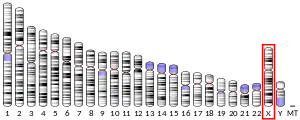OPN1MW
Green-sensitive opsin is a protein that in humans is encoded by the OPN1MW gene.[3] OPN1MW2 is a similar opsin.
| OPN1MW | |||||||||||||||||||||||||||||||||||||||||||||||||||
|---|---|---|---|---|---|---|---|---|---|---|---|---|---|---|---|---|---|---|---|---|---|---|---|---|---|---|---|---|---|---|---|---|---|---|---|---|---|---|---|---|---|---|---|---|---|---|---|---|---|---|---|
| Identifiers | |||||||||||||||||||||||||||||||||||||||||||||||||||
| Aliases | OPN1MW, CBBM, CBD, COD5, GCP, GOP, OPN1MW1, opsin 1 (cone pigments), medium-wave-sensitive, opsin 1, medium wave sensitive | ||||||||||||||||||||||||||||||||||||||||||||||||||
| External IDs | OMIM: 300821 HomoloGene: 88332 GeneCards: OPN1MW | ||||||||||||||||||||||||||||||||||||||||||||||||||
| |||||||||||||||||||||||||||||||||||||||||||||||||||
| |||||||||||||||||||||||||||||||||||||||||||||||||||
| |||||||||||||||||||||||||||||||||||||||||||||||||||
| |||||||||||||||||||||||||||||||||||||||||||||||||||
| Wikidata | |||||||||||||||||||||||||||||||||||||||||||||||||||
| |||||||||||||||||||||||||||||||||||||||||||||||||||
See also
References
- GRCh38: Ensembl release 89: ENSG00000268221 - Ensembl, May 2017
- "Human PubMed Reference:". National Center for Biotechnology Information, U.S. National Library of Medicine.
- "Entrez Gene: OPN1MW opsin 1 (cone pigments), medium-wave-sensitive (color blindness, deutan)".
Further reading
- Applebury ML, Hargrave PA (1987). "Molecular biology of the visual pigments". Vision Res. 26 (12): 1881–95. doi:10.1016/0042-6989(86)90115-X. PMID 3303660. S2CID 34038855.
- Winderickx J, Sanocki E, Lindsey DT, et al. (1993). "Defective colour vision associated with a missense mutation in the human green visual pigment gene". Nat. Genet. 1 (4): 251–6. doi:10.1038/ng0792-251. PMID 1302020. S2CID 23127406.
- Neitz J, Neitz M, Jacobs GH (1990). "Analysis of fusion gene and encoded photopigment of colour-blind humans". Nature. 342 (6250): 679–82. doi:10.1038/342679a0. PMID 2574415. S2CID 4273929.
- Nathans J, Thomas D, Hogness DS (1986). "Molecular genetics of human color vision: the genes encoding blue, green, and red pigments". Science. 232 (4747): 193–202. Bibcode:1986Sci...232..193N. CiteSeerX 10.1.1.461.5915. doi:10.1126/science.2937147. PMID 2937147.
- Li ZY, Kljavin IJ, Milam AH (1995). "Rod photoreceptor neurite sprouting in retinitis pigmentosa". J. Neurosci. 15 (8): 5429–38. doi:10.1523/JNEUROSCI.15-08-05429.1995. PMC 6577619. PMID 7643192.
- Ladekjaer-Mikkelsen AS, Rosenberg T, Jørgensen AL (1996). "A new mechanism in blue cone monochromatism". Hum. Genet. 98 (4): 403–8. doi:10.1007/s004390050229. PMID 8792812. S2CID 11799731.
- Ferreira PA, Nakayama TA, Pak WL, Travis GH (1996). "Cyclophilin-related protein RanBP2 acts as chaperone for red/green opsin". Nature. 383 (6601): 637–40. Bibcode:1996Natur.383..637F. doi:10.1038/383637a0. PMID 8857542. S2CID 4304490.
- Vissers PM, Bovee-Geurts PH, Portier MD, et al. (1998). "Large-scale production and purification of the human green cone pigment: characterization of late photo-intermediates". Biochem. J. 330 (3): 1201–8. doi:10.1042/bj3301201. PMC 1219262. PMID 9494086.
- Bernstein SL, Wong P (1998). "Regional expression of disease-related genes in human and monkey retina". Mol. Vis. 4: 24. PMID 9815288.
- Hayashi T, Motulsky AG, Deeb SS (1999). "Position of a 'green-red' hybrid gene in the visual pigment array determines colour-vision phenotype". Nat. Genet. 22 (1): 90–3. doi:10.1038/8798. PMID 10319869. S2CID 1326234.
- Ueyama H, Kuwayama S, Imai H, et al. (2002). "Novel missense mutations in red/green opsin genes in congenital color-vision deficiencies". Biochem. Biophys. Res. Commun. 294 (2): 205–9. doi:10.1016/S0006-291X(02)00458-8. PMID 12051694.
- Zhu X, Brown B, Li A, et al. (2003). "GRK1-dependent phosphorylation of S and M opsins and their binding to cone arrestin during cone phototransduction in the mouse retina". J. Neurosci. 23 (14): 6152–60. doi:10.1523/JNEUROSCI.23-14-06152.2003. PMC 6740345. PMID 12853434.
- Bonilha VL, Hollyfield JG, Grover S, Fishman GA (2005). "Abnormal distribution of red/green cone opsins in a patient with an autosomal dominant cone dystrophy". Ophthalmic Genet. 26 (2): 69–76. doi:10.1080/13816810590968041. PMID 16020309. S2CID 24486298.
This article is issued from Wikipedia. The text is licensed under Creative Commons - Attribution - Sharealike. Additional terms may apply for the media files.

